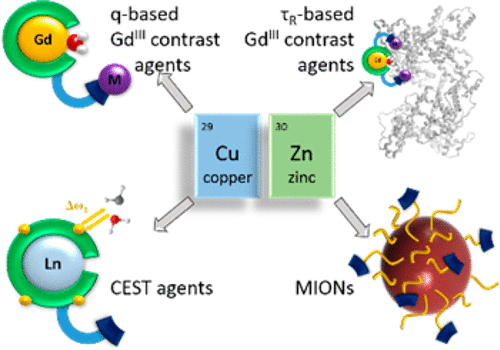当前位置:
X-MOL 学术
›
Acc. Chem. Res.
›
论文详情
Our official English website, www.x-mol.net, welcomes your
feedback! (Note: you will need to create a separate account there.)
Comparing Strategies in the Design of Responsive Contrast Agents for Magnetic Resonance Imaging: A Case Study with Copper and Zinc
Accounts of Chemical Research ( IF 16.4 ) Pub Date : 2018-01-22 00:00:00 , DOI: 10.1021/acs.accounts.7b00301 Valérie C. Pierre 1 , Sarah M. Harris 1 , Sylvie L. Pailloux 1
Accounts of Chemical Research ( IF 16.4 ) Pub Date : 2018-01-22 00:00:00 , DOI: 10.1021/acs.accounts.7b00301 Valérie C. Pierre 1 , Sarah M. Harris 1 , Sylvie L. Pailloux 1
Affiliation

|
Magnetic resonance imaging (MRI) has emerged over the years as one of the preferred modalities for medical diagnostic and biomedical research. It has the advantage over other imaging modalities such as positron emission tomography and X-ray of affording high resolution three-dimensional images of the body without using harmful radiation. The use of contrast agents has further expanded this technique by increasing the contrast between regions where they accumulate and background tissues. As MRI most often measures the relaxation rate of water throughout the body, contrast agents function by modulating the intensity of the water signal either via improved relaxation or via saturation transfer to selected exchangeable proton. Among the growing class of MRI contrast agents, a subset of them called “smart” contrast agents function as responsive probes. Their ability to increase or decrease their signal intensity is modulated by the presence of an analyte. These probes offer the unique ability to image the distribution of an analyte in vivo, thereby opening new possibilities for diagnostics and for elucidating the role of specific analytes in various pathologies or biological processes. A number of different strategies can be exploited to design responsive MRI contrast agents. The majority of contrast agents are based on GdIII complexes. These complexes can be rendered responsive in either of two ways: either by modulating the number of inner-sphere water molecules, q, or via modulating the rotational correlation time, τR, of the contrast agent upon substrate binding. The longitudinal relaxivity increases with the number of inner-sphere water molecules. GdIII complexes can be rendered responsive if they contain a recognition moiety that can bind to both the open coordination site of GdIII and to the analyte. When the recognition moiety leaves the lanthanide ion to bind to the analyte, q increases and therefore so does the relaxivity. The dependence of relaxivity on rotational correlation time is more complex and more pronounced at lower magnetic fields. In general, slower tumbling macromolecules have longer rotational correlation times and higher relaxivities. Analyte-triggered formation of macromolecules thus also increases relaxivity. Such macromolecules can either be analyte-templated supramolecular assemblies, or analyte-enhanced protein-contrast agent complexes. Chemical Exchange Saturation Transfer (CEST) agents are a newer class of contrast agents that offer the possibility of multifrequency and thus ratiometric imaging, which in turn enables quantitative mapping of the concentration of an analyte in vivo under conditions where the concentration of the contrast agent is not known. Such agents can be rendered responsive if the analyte changes the number of exchangeable proton(s), its exchange rate, or its chemical shift. All of these approaches have been successfully employed for detecting and imaging both copper and zinc, including in vivo. Magnetic Iron Oxide Nanoparticles (MIONs) are powerful MRI transverse relaxation agents. They can also be rendered responsive to an analyte if the latter can control the aggregation of the nanoparticles. For metal ions, this can be achieved via chemical functionalities that only react to form conjugates in the presence of the metal ion analyte.
中文翻译:

磁共振成像反应性对比剂设计中的比较策略:以铜和锌为例
多年来,磁共振成像(MRI)已成为医学诊断和生物医学研究的首选方式之一。它具有优于其他成像方式(例如正电子发射断层扫描和X射线)的优势,可以在不使用有害辐射的情况下提供人体的高分辨率三维图像。造影剂的使用通过增加它们积聚的区域与背景组织之间的对比度,进一步扩展了该技术。由于MRI最经常测量的是整个身体中水的松弛率,因此造影剂可通过改善松弛度或通过饱和转移到选定的可交换质子来调节水信号的强度来发挥作用。在不断增长的MRI造影剂类别中,其中的一个子集(称为“智能”造影剂)起着响应探针的作用。它们增加或减少信号强度的能力通过分析物的存在来调节。这些探针具有独特的能力,可以对体内分析物的分布进行成像,从而为诊断和阐明特定分析物在各种病理学或生物过程中的作用开辟了新的可能性。可以利用许多不同的策略来设计响应性MRI造影剂。大多数造影剂是基于Gd的 可以利用许多不同的策略来设计响应性MRI造影剂。大多数造影剂是基于Gd的 可以利用许多不同的策略来设计响应性MRI造影剂。大多数造影剂是基于Gd的III配合物。这些配合物可以响应于以下两种方式之一来呈现:或者通过调节内球的水分子的数目q,或通过调节旋转相关时间,τ ř在底物结合中,造影剂的。纵向弛豫率随内球水分子数量的增加而增加。如果Gd III复合物包含可以与Gd III的开放配位位点和分析物结合的识别部分,则可以使其具有响应性。当识别部分离开镧系元素离子与分析物结合时,q增加,因此松弛度也增加。弛豫度对旋转相关时间的依赖性在较低的磁场下更加复杂并且更加明显。通常,较慢的翻滚大分子具有更长的旋转相关时间和更高的弛豫度。因此,大分子的分析物触发形成也增加了弛豫性。这样的大分子可以是分析物模板化的超分子组装体,也可以是分析物增强的蛋白质对比剂复合物。化学交换饱和转移(CEST)试剂是一类新型的造影剂,它提供了多频成像和比率成像的可能性,这反过来又使得能够在造影剂浓度为10%的条件下定量分析体内分析物的浓度。未知。如果分析物改变可交换质子的数量,其交换速率或其化学位移,则可以使此类试剂具有响应性。所有这些方法已被成功地用于检测和成像铜和锌,包括在体内。磁性氧化铁纳米粒子(MIONs)是强大的MRI横向松弛剂。如果分析物可以控制纳米颗粒的聚集,则它们也可以响应分析物。对于金属离子,这可以通过仅在金属离子分析物存在下反应形成共轭物的化学官能团来实现。磁性氧化铁纳米粒子(MIONs)是强大的MRI横向松弛剂。如果分析物可以控制纳米颗粒的聚集,则它们也可以响应分析物。对于金属离子,这可以通过仅在金属离子分析物存在下反应形成共轭物的化学官能团来实现。磁性氧化铁纳米粒子(MIONs)是强大的MRI横向松弛剂。如果分析物可以控制纳米颗粒的聚集,则它们也可以响应分析物。对于金属离子,这可以通过仅在金属离子分析物存在下反应形成共轭物的化学官能团来实现。
更新日期:2018-01-22
中文翻译:

磁共振成像反应性对比剂设计中的比较策略:以铜和锌为例
多年来,磁共振成像(MRI)已成为医学诊断和生物医学研究的首选方式之一。它具有优于其他成像方式(例如正电子发射断层扫描和X射线)的优势,可以在不使用有害辐射的情况下提供人体的高分辨率三维图像。造影剂的使用通过增加它们积聚的区域与背景组织之间的对比度,进一步扩展了该技术。由于MRI最经常测量的是整个身体中水的松弛率,因此造影剂可通过改善松弛度或通过饱和转移到选定的可交换质子来调节水信号的强度来发挥作用。在不断增长的MRI造影剂类别中,其中的一个子集(称为“智能”造影剂)起着响应探针的作用。它们增加或减少信号强度的能力通过分析物的存在来调节。这些探针具有独特的能力,可以对体内分析物的分布进行成像,从而为诊断和阐明特定分析物在各种病理学或生物过程中的作用开辟了新的可能性。可以利用许多不同的策略来设计响应性MRI造影剂。大多数造影剂是基于Gd的 可以利用许多不同的策略来设计响应性MRI造影剂。大多数造影剂是基于Gd的 可以利用许多不同的策略来设计响应性MRI造影剂。大多数造影剂是基于Gd的III配合物。这些配合物可以响应于以下两种方式之一来呈现:或者通过调节内球的水分子的数目q,或通过调节旋转相关时间,τ ř在底物结合中,造影剂的。纵向弛豫率随内球水分子数量的增加而增加。如果Gd III复合物包含可以与Gd III的开放配位位点和分析物结合的识别部分,则可以使其具有响应性。当识别部分离开镧系元素离子与分析物结合时,q增加,因此松弛度也增加。弛豫度对旋转相关时间的依赖性在较低的磁场下更加复杂并且更加明显。通常,较慢的翻滚大分子具有更长的旋转相关时间和更高的弛豫度。因此,大分子的分析物触发形成也增加了弛豫性。这样的大分子可以是分析物模板化的超分子组装体,也可以是分析物增强的蛋白质对比剂复合物。化学交换饱和转移(CEST)试剂是一类新型的造影剂,它提供了多频成像和比率成像的可能性,这反过来又使得能够在造影剂浓度为10%的条件下定量分析体内分析物的浓度。未知。如果分析物改变可交换质子的数量,其交换速率或其化学位移,则可以使此类试剂具有响应性。所有这些方法已被成功地用于检测和成像铜和锌,包括在体内。磁性氧化铁纳米粒子(MIONs)是强大的MRI横向松弛剂。如果分析物可以控制纳米颗粒的聚集,则它们也可以响应分析物。对于金属离子,这可以通过仅在金属离子分析物存在下反应形成共轭物的化学官能团来实现。磁性氧化铁纳米粒子(MIONs)是强大的MRI横向松弛剂。如果分析物可以控制纳米颗粒的聚集,则它们也可以响应分析物。对于金属离子,这可以通过仅在金属离子分析物存在下反应形成共轭物的化学官能团来实现。磁性氧化铁纳米粒子(MIONs)是强大的MRI横向松弛剂。如果分析物可以控制纳米颗粒的聚集,则它们也可以响应分析物。对于金属离子,这可以通过仅在金属离子分析物存在下反应形成共轭物的化学官能团来实现。










































 京公网安备 11010802027423号
京公网安备 11010802027423号